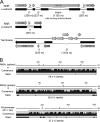Brochothrix thermosphacta bacteriophages feature heterogeneous and highly mosaic genomes and utilize unique prophage insertion sites
- PMID: 20709901
- PMCID: PMC2950505
- DOI: 10.1128/JB.00709-10
Brochothrix thermosphacta bacteriophages feature heterogeneous and highly mosaic genomes and utilize unique prophage insertion sites
Abstract
Brochothrix belongs to the low-GC branch of Gram-positive bacteria (Firmicutes), closely related to Listeria, Staphylococcus, Clostridium, and Bacillus. Brochothrix thermosphacta is a nonproteolytic food spoilage organism, adapted to growth in vacuum-packaged meats. We report the first genome sequences and characterization of Brochothrix bacteriophages. Phage A9 is a myovirus with an 89-nm capsid diameter and a 171-nm contractile tail; it belongs to the Spounavirinae subfamily and shares significant homologies with Listeria phage A511, Staphylococcus phage Twort, and others. The A9 unit genome is 127 kb long with 11-kb terminal redundancy; it encodes 198 proteins and 6 tRNAs. Phages BL3 and NF5 are temperate siphoviruses with a head diameter of 56 to 59 nm. The BL3 tail is 270 nm long, whereas NF5 features a short tail of only 94 nm. The NF5 genome (36.95 kb) encodes 57 gene products, BL3 (41.52 kb) encodes 65 products, and both are arranged in life cycle-specific modules. Surprisingly, BL3 and NF5 show little relatedness to Listeria phages but rather demonstrate relatedness to lactococcal phages. Peptide mass fingerprinting of viral proteins indicate programmed -1 translational frameshifts in the NF5 capsid and the BL3 major tail protein. Both NF5 and BL3 feature circularly permuted, terminally redundant genomes, packaged by a headful mechanism, and integrases of the serine (BL3) and tyrosine (NF5) types. They utilize unique target sequences not previously described: BL3 inserts into the 3' end of a RNA methyltransferase, whereas NF5 integrates into the 5'-terminal part of a putative histidinol-phosphatase. Interestingly, both genes are reconstituted by phage sequence.
Figures







Similar articles
-
Comparative genome analysis of Listeria bacteriophages reveals extensive mosaicism, programmed translational frameshifting, and a novel prophage insertion site.J Bacteriol. 2009 Dec;191(23):7206-15. doi: 10.1128/JB.01041-09. Epub 2009 Sep 25. J Bacteriol. 2009. PMID: 19783628 Free PMC article.
-
Complete nucleotide sequence, molecular analysis and genome structure of bacteriophage A118 of Listeria monocytogenes: implications for phage evolution.Mol Microbiol. 2000 Jan;35(2):324-40. doi: 10.1046/j.1365-2958.2000.01720.x. Mol Microbiol. 2000. PMID: 10652093
-
Morphology of Brochothrix thermosphacta phages.Microbios. 1988;56(226):19-26. Microbios. 1988. PMID: 3237117
-
The SPO1-related bacteriophages.Arch Virol. 2010 Oct;155(10):1547-61. doi: 10.1007/s00705-010-0783-0. Epub 2010 Aug 17. Arch Virol. 2010. PMID: 20714761 Review.
-
Tailed bacteriophages: the order caudovirales.Adv Virus Res. 1998;51:135-201. doi: 10.1016/s0065-3527(08)60785-x. Adv Virus Res. 1998. PMID: 9891587 Free PMC article. Review.
Cited by
-
On-going issues regarding biofilm formation in meat and meat products: challenges and future perspectives.Poult Sci. 2024 Oct 1;103(12):104373. doi: 10.1016/j.psj.2024.104373. Online ahead of print. Poult Sci. 2024. PMID: 39426218 Free PMC article. Review.
-
A Genome of Temperate Enterococcus Bacteriophage Placed in a Space of Pooled Viral Dark Matter Sequences.Viruses. 2023 Jan 12;15(1):216. doi: 10.3390/v15010216. Viruses. 2023. PMID: 36680256 Free PMC article.
-
Isolation and Characterization of a Novel Siphoviridae Phage, vB_AbaS_TCUP2199, Infecting Multidrug-Resistant Acinetobacter baumannii.Viruses. 2022 Jun 7;14(6):1240. doi: 10.3390/v14061240. Viruses. 2022. PMID: 35746711 Free PMC article.
-
Comparative analysis of quality and microbial safety of ohmic and water bath cooked pork batter during refrigerated storage.J Food Sci Technol. 2020 Jul;57(7):2461-2471. doi: 10.1007/s13197-020-04281-0. Epub 2020 Feb 21. J Food Sci Technol. 2020. PMID: 32549596 Free PMC article.
-
One complete and three draft genome sequences of four Brochothrix thermosphacta strains, CD 337, TAP 175, BSAS1 3 and EBP 3070.Stand Genomic Sci. 2018 Oct 10;13:22. doi: 10.1186/s40793-018-0333-z. eCollection 2018. Stand Genomic Sci. 2018. PMID: 30338025 Free PMC article.
References
-
- Ackermann, H.-W., G. G. Greer, and J. Rocourt. 1988. Morphology of Brochothrix thermosphacta phages. Microbios 56:19-26. - PubMed
-
- Adams, M. H. 1959. Methods of study of bacterial viruses, p. 443-457. In Bacteriophages. Interscience Publishers, Inc., New York, NY.
-
- Alemayehu, D., R. P. Ross, O. O'Sullivan, A. Coffey, C. Stanton, G. F. Fitzgerald, and O. McAuliffe. 2009. Genome of a virulent bacteriophage Lb338-1 that lyses the probiotic Lactobacillus paracasei cheese strain. Gene 448:29-39. - PubMed
-
- Auzat, I., A. Droge, F. Weise, R. Lurz, and P. Tavares. 2008. Origin and function of the two major tail proteins of bacteriophage SPP1. Mol. Microbiol. 70:557-569. - PubMed
MeSH terms
Substances
LinkOut - more resources
Full Text Sources
Other Literature Sources
Miscellaneous

